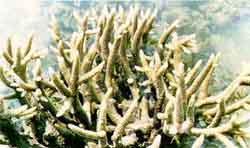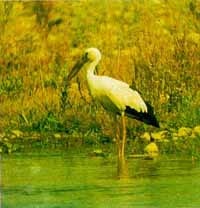
[Biosphere Reserves, Wetlands, Mangroves, Coral Reefs, Bio-diversity, Bio-safety Protocol, Capacity Building in Taxonomy, Desertification, Assistance to Botanic Gardens, National Botanic Garden, Medicinal Plants, Forest Conservation, Regional Offices, Forest Legislation, JFM, National Forestry Action Programme, National Zoological Park, Indian Board for Wildlife, Schemes for Tribal Development, Project Tiger, Project Elephant and Central Zoo Authority]
The Ministry has enunciated several policy instruments and has introduced various Action Programmes to address the problems of environment and development holistically as well as to consider several cross-sectoral issues having a direct bearing on conservation and sustainable uses of natural resources including forestry and wildlife.
IndexAreas rich in biodiversity and encompassing unique and representative ecosystems are identified and designated as Biosphere Reserves. The goal is to facilitate conservation of representative landscapes and India’s immense biological diversity which is estimated to be over 47,000 plant species and 81,000 animal species, representing about 7% of the world’s flora and 6.5% of world’s fauna respectively.
The programme is a pioneering effort at pursuing the increasingly difficult yet urgent task of conserving ecological diversity under mounting pressures. The emphasis of the programme is on conservation of landscapes, ecosystems, species and genetic variations: promote economic development which is culturally, socially and ecologically sustainable and to provide support for research, monitoring, education and information exchange related to local, national and global issues.

The twelve Biosphere Reserves set up so far not only aim at protecting representative ecosystems, but also serve as laboratories for evolving alternative models of development. The Ministry provided financial assistance to the respective State Governments for conservation and management of these Biosphere Reserves. Research and development projects were also supported. An area comprising 2619.92 sq. km of the Kanchanjanga hills in Sikkim was designated as the 12th Biosphere Reserve in the country. Approximately, three-forth area of the Valley of Flowers in Garhwal Himalaya was merged to the existing Nanda Devi Biosphere Reserve, which has resulted in the revision of the total area of the Nanda Devi BR from existing 2236.74 sq km to 5860.69 sq. km. A set of guidelines for protection, maintenance, research and development in the Biosphere Reserve in India were brought out for wider circulation among stakeholders. The details of the research projects completed and new research projects initiated are given in Annexure IV and III respectively. A list of Biosphere Reserves set up so far is also given in Table- 2.
---------------------------------------------------------------------------------------------------------------- Sl.No. Name of the site Date of Notification Location (State) ---------------------------------------------------------------------------------------------------------------- 1 Nilgiri 1.8.86 Parr of Wynad, Nagarhole, Bandipur and Madumalai, Nilambur, Silent Valley and Siruvani hills (Tamil Nadu, Kerala and Karnataka). 2 Nanda Devi 18.1.88 Par of Chamoli, Pithoragarh & Almora Districts (Uttar Pradesh). 3 Nokrek 1.9.88 Part of Garo Hills (Meghalaya). 4 Manas 14.3.89 Part of Kokrajhar, Bongaigaon, Barpeta, Nalbari, Kamprup and Darang Districts (Assam). 5 Sunderbans 29.3.89 Part of delta of Ganges & Brahamaputra river system (West Bengal). 6 Gulf of Mannar 18.2.89 Indian part of Gulf of Mannar between India and Sri Lanka (Tamil Nadu). 7 Great Nicobar 6.1.89 Southern most islands of Andaman and Nicobar (A&N Islands). 8 Similipal 21.6.94 Part of Mayurbhanj district (Orissa). 9 Dibru-Saikhowa 28.7.97 Part of Dibrugarh and Tinsukia Districts (Assam). 10 Dehang Debang 02.09.98 Part of Siang and Debang valley in Arunachal Pradesh. 11 Pachmarhi 03.03.99 Parts of Betul, Hoshangabad and Chindwara districts of Madhya Pradesh. 12 Kanchanjanga 07.02.2000 Parts of Kanchanjanga Hills and Sikkim. ----------------------------------------------------------------------------------------------------------------Index
Wetland Conservation Programme has been operational since 1987 to lay down policy guidelines for implementing programs related to conservation and management of wetland in the country, to involve people in wetland management activities, who are living around these areas and depend for their livelihood entirely on wetland, to initiate economic evaluation of wetland in order to understand wetland habitat from cost benefit point of view, to prepare an updated inventory of Indian wetland and to lay more stress on problems related to hydrological aspects, wetland mapping, landscape planning and R & D activities as per newly framed guidelines and to understand aspects of wetland processes and functioning.

With these major objectives, National Committee on Conservation of wetland was constituted which identified 20 wetlands in the country for intensive conservation and management. Management Action Plans for 16 wetland have already been prepared and are in operation. 100% central assistance is given to the concerned State Governments under National Wetland Conservation Programme for activities like survey and demarcation, mapping, landscape planning, hydrology, control of encroachment eutrophication abatement, aquatic weed control, wildlife conservation, fisheries development, environment awareness and research concerning structure in function of aquatic eco-systems.
Under Global Environment Facility (GEF), a project on conservation and sustainable use of globally significant threatened wetland of India has been approved at a total cost of Rs 10 lakhs. Under this Programme, it is proposed to take up conservation of three wetland viz. Kabar in Bihar. Kolleru in Andhra Pradesh and Wullar in J&K.
A policy decision was taken in the National Wetland Committee to give financial assistance only to those research projects, which are related to only identified wetland/lakes identified by the Ministry.
Technical Advisory Committee for Management of Loktak Lake has been specially constituted to coordinate activities pertaining to conservation of Loktak Lake as it is getting assistance from different agencies like Indo-Canadian Environment Faculty, Ministry of Environment and Forests, Tenth and Eleventh Finance Commissions, State Government, North-East Council etc.

Under small grants fund form Ramsar Bureau, an amount of Rs. 40000 Swiss francs for studying economic evaluation of Harike Wetland in Punjab has been received which is under implementation through Wetland International South Asia in collaboration with State Council of Science and Technology, Punjab Government. Two more projects under small grants funds have been posed to Ramsar Bureau for assistance.
Being a party to Ramsar Convention of Wetland, India participated in 7th meeting of the Ramsar Convention held in Costa Rica from 10-18 May, 1999. The salient features were:
India was elected to serve on the Standing Committee from Asian Region along with Japan for the next triennium.
India chaired the session on Ramsar and Water use on the draft resolution guidelines for integrating wetland conservation and wise use in to river basin management.
On intervention of WWF International, India assured to try and declare at least 20 Ramsar sites in the next triennium.
Mangroves are woody plants that grow at the inter-tidal zones of sheltered shores, estuaries, tidal creeks, backwaters, lagoons, marshes and mud flats in the tropical and sub-tropical regions of the world. These plants exist under very hostile and inhospitable conditions. They have to encounter higher salinity, tidal extremes, heavy winds, high temperature and anaerobic soil substrates there by developing peculiar adoptive morphological features and physiological mechanisms such as supporting and breathing roots, viviparous germination, salt excreting leaves etc. Mangroves and their associates together constitute a fragile coastal ecosystem supporting rich microbial, floral and faunal components. These constitutes important ecological asset and economic resource in the coastal marine environment. Mangrove forests are among the most productive ecosystems and play an important role in protection of the coastal areas, fertilization of the sea and serve as the breeding and feeding grounds for prawns and fishes.
Realizing the importance of mangroves, Government of India initiated efforts for their conservation and management in late 1950’s. They were declared as ecologically sensitive areas under the Environmental Protection Act, 1986 banning their exploitation followed by a Coastal Zone Regulation Notification 1991 prohibiting developmental activities and disposal of wastes in the mangrove areas. The Ministry initiated a Plan Scheme on Conservation and Management of Mangroves and Coral Reefs in 1986 and constituted a National Committee to advise the Government on relevant policies and programmes. On the recommendations of this Committee 15 mangrove areas in the country have been identified for intensive conservation. Management Action Plan (MAPs) submitted by the concerned States/Union Territories are considered by the Ministry for financial assistance. Steering Committees at the State level have been constituted to oversee the progress of implementation of these Management Action Plans. Research activities are also encouraged by the Ministry and a Research Sub Committee has been constituted for this purpose.

As a follow-up of the recommendations of these Committees made during September, 1998 Guidelines for preparation, implementation and monitoring of the Management Action Plans have been reviewed and user friendly formats were developed. During the year, Management Action Plans for the following mangrove areas were recommended.
Surderbans (West Bengal)
Mahanadi Delta and Bhitarkanika Sanctuary (Orissa)
Pitchavaran and Muthupet (TamilNadu)
Goa and
Achra-Ratanagiri (Maharastra)
Other States have also been advised to submit these plans on the identified mangrove areas for consideration of the Ministry.

To integrate research with management, thrust areas have been prepared and relevant academic institutions adjoining the respective mangrove areas have been identified. Concerned States/Union Territories were advised to constitute Research Sub-Committees at their level to identify threats and recommend the research projects on these thrust areas for financial assistance from the Ministry. Exhaustive literature on Indian Mangroves was scanned and a draft of the Review Paper on these research contributions has been prepared. A Status Paper on Indian Mangroves and draft of the Atlas of Indian Mangroves have also been prepared and are being finalized after consultations with experts. Efforts to establish Database Network on Indian Mangroves were initiated. Proposals for this purpose received form the potential institutions are being examined.
In the light of the recent Super Cyclone in Orissa and significant role played by mangroves in the coastal protection, a Task Force has been constituted for rapid assessment of the status of mangroves in the state and assist the Government in identification of suitable sites for rehabilitation and afforestation of mangroves, prepare Management Action Plans and develop strategies for their implementation and monitoring. The Task force has recommended the establishment of a Mangrove Genetic Resource Centre in Bhitarkanika and identified Devi and Subarnarekha Delta in Orissa for mangrove afforestation. As an eco-restoration measure, Management Action Plans on Mahanadi Delta and Bhitarkanika Mangroves in Orissa were approved by the Ministry and financial assistance of Rs. 46.50 lakhs was extended for implementation of these plans. Major activities include survey and demarcation, afforestation and rehabilitation and protection of Mangroves as well as Eco-development activities leading to sustainable livelihood options of the local community and awareness in these areas.

Ministry also reviewed the implementation of the on-going Scheme and an out line of the programme on mangrove afforestation and restoration in the suitable areas along the East and West coast of the country has been prepared. It is being finalized after consultations with the concerned State/UTs. Proposal of the Food and Agricultural Organization of the United Nations to nominate consultants for preparation of a Mangrove Development Programme in the country was considered by the Ministry and names of mangrove experts from the reputed academic institutions in the country have been communicated to FAO. The Ministry is represented on the Steering Committee of the project on Coastal Wetlands of East Coast of India implemented by M.S. Swaminathan Research Foundation (MSSRF), Chennai through the grants from India Canada Environmental Facility (ICEF). Progress of implementation of this project is monitored by the Ministry. Similar project for West Coast of India has been planned and dialogue with ICEF to this effect has already been initiated.
IndexCoral Reefs are shallow water tropical ecosystems characterised by the remarkably high biomass production and rich floral and faunal diversity. Coral Reefs are particularly important to millions of people around the word as sources of high quality protein and cultural products. They provide raw materials for dwellings along the coast and protect fragile shoreline from damage and erosion. They are also of great value to the world at large as the hotspots of marine bio-diversity. Recent estimates reveal that 95 per cent of the world’s Coral Reefs have been damaged by over-fishing, dynamiting, pollution, poisoning or ship’s anchor. The latest event of bleaching in Indian Ocean has caused considerable damage to the Coral Reefs in India.

Taking into consideration the importance of Coral Reefs and the factors responsible for their deterioration, following areas in the country have been identified for conservation and management:-
Andaman & Nicobar Islands
Lakshadweep
Gulf of Mannar and
Gulf of Kutch
Financial assistance is extended to the concerned States/UTs for implementation of Management Action Plans. During the year plans submitted by Andaman and Nicobar and Lakshadweep Administration have been sanctioned. On the recommendations of the meetings of the Research Sub-Committee and National Committee on Mangroves and Coral Reefs, thrust areas for research and relevant institutions working on Coral Reefs have been identified. Research projects on monitoring health of Coral Reefs in Gulf of Mannar have been assigned to Madurai Kamraj University and Annamalai University. Draft of the Status of Coral Reefs in India has been prepared. Efforts have been initiated to establish Indian Coral Reef Monitoring Network (ICRMN) to integrate various activities on Coral Reefs through national and international initiatives. Institutions for Database Networking and capacity and training on Coral Reefs have been identified. Infrastructure for this purpose has been strengthen at Port Blair and Lakshadweep Islands. Training programmes on Scuba diving and Taxonomy of Coral Reefs have launched at Port Blair.
The Ministry is represented on Global Coral Reef Monitoring Network (GCRMN) and in the fist phase of the GCRMN South Asia, Monitoring Action Plans (MAPs) on Coral Reefs in Andaman and Nicobar, Lakshadweep and Gulf of Mannar have been prepared for their implementation through the Ministry. The Ministry has also been designated as a Focal Point of the International Coral Reef Initiative (ICRI) and representative of the Ministry participated in the Planning and Coordination Committee of ICRI.
An important project through UNDP/ GEF PDF B Grants on Gulf of Mannar Biosphere Reserve was successfully implemented through Dr. Swaminathan Research Foundation (MSSRF), Chennai and a draft document for the major GEF grant is being finalised as an outcome of this project. Another PDF B Project on Management of Coral Reef Ecosystem in Andaman and Nicobar Islands is in its concluding phase and has resulted in a valuable documentation on the subject.
The term "biodiversity" encompasses the variety of all life on Earth. It is defined as the variability among living organisms and the ecological complexes of which they are part, including diversity within and between species and ecosystems. Biodiversity manifests at species, genetic and ecosystem levels.
Biological diversity has direct consumptive value in food, agriculture, medicine, industry, etc. It also has aesthetic and recreational value. Biodiversity maintains ecological balance and continues evolutionary processes. The indirect ecosystem services provided through biodiversity are photosynthesis, pollination, transpiration, chemical cycling, nutrient cycling, soil maintenance, climate regulation, air, water system management, waste treatment and pest control.
India is one of the 12 mega-biodiversity countries of the world. From about 70% of the total geographical area surveyed so far, 46,000 plant species and 81,000 animal species have been described.
India became a Party to the International Convention on Biological Diversity (CBD) in May, 1994. The three objectives of the Convention are:-
Conservation of biological diversity.
Sustainable use of components of biological diversity and.
Fair and equitable sharing of benefits arising out of the utilisation of genetic resources.
The scheme on Biodiversity Conservation was initiated during 1991-92 to ensure coordination among various agencies dealing with issues relating to conservation of biodiversity, and to review, monitor and evolve adequate policy instruments for the same.
Activities undertaken during the year are as follows:
Biodiversity is a multi-disciplinary subject involving diverse sectoral activities and actions. Adopting a consultative process with the stakeholders, a draft National Policy and Action Strategy on Biological Diversity has been drawn up as a macro-level statement of strategies, gaps and further actions needed for conservation, sustainable use and strategies and realization of actual and potential value of biological diversity. Emphasizing the need for conservation and analyzing provisions of the Convention, the draft identifies the basic goals and thrust areas and outlines action points for various subjects. The document was formally released by the Secretary (E&F) on 6.1.2000.

Emphasizing the need for conservation, the policy sets out major goals and identifies thrust areas for actions for conservation of biodiversity. The goals include:-
Securing integration of biodiversity concerns in sectoral programmes and policies.
Securing participation of all stakeholder in conservation and sustainable use of biodiversity;
Realisation of consumptive and non-consumptive value of biodiversity through necessary R&D investments and biotechnology developments;
Securing benefits to India as country of origin and to its people as creators and holders of knowledge; and
The thrust areas include identification of gaps in conservation; sustainable use, ecosystem protection, institutional capacity building at all levels and networking; legal framework; and participation of all stakeholders in the implementation.
 (Adansonia digitata L.) growing at Jhusi (Allahabad)">
(Adansonia digitata L.) growing at Jhusi (Allahabad)">
Current efforts, gaps and action points have been identified for the following eleven subject areas:
legal and policy framework;
survey of biodiversity and national database;
in-situ conservation;
ex-situ conservation;
sustainable utilization;
indigenous knowledge systems; innovations and practices and benefit sharing;
people’s participation;
institutional framework and capacity building;
education, training and extension;
research and development activities; and
international cooperation.
The framework document will provide the basis for developing detailed actions at micro and regional levels. An inter-ministerial supervisory committee consisting of Ministry of Agriculture, DBT, DOD, DSIR, etc, would oversee and monitor implementation of the action plan.

India’s richness in biological resources and indigenous knowledge relating to them is well recognised. One of the major challenges is in adopting an instrument, which help realise the objectives of equitable benefit sharing enshrined in the Convention. Towards this, an outline of biodiversity legislation has been prepared which aims at regulating access to biological resources and making such access subject to terms and conditions which secure equitable sharing of benefits for the resources accessed. This has been done through a consultation process with the stakeholder, local people, industry, practitioners of indigenous systems of health care and medicine, technical and academic institutions, state governments, institutions of self government, trade and business. Further actions for introducing the bill in the Parliament have been initiated.
Recognising the potential risks of genetically engineered organism, the Convention on Biological Diversity (CBD), has addressed this issue of biosafety as it is commonly called, in the Articles 8(g), 19.3 and 19.4.

An Ad-hoc Working Group under the aegis of Convention on Biological Diversity has negotiated a draft protocol on biosafety. The inter-ministerial Task Force on Biosafety set up for developing India’s stand in the international negotiations for a protocol on biosafety, continued its work during the year. Meetings of the Task Force were held for working out India’s position for this purpose. India participated actively in the international negotiations for biosafety protocol. India’s position for the resumed Ex-CoP to finalize and adopt the protocol has been prepared after inter-ministerial consultations.
After identification of critically important areas and gaps in taxonomic work, an all India Co-ordinated project was drawn up for Capacity building in taxonomy. A meeting of experts was held to discuss the modalities of implementing the All India Coordinated Project on Taxonomy (AICOPTAX). Nine Centres for Research and two Centres for Training along with the Coordinating and Collaborating units have been identified. The priority areas identified include:-
Animal viruses.
Bacteria and Archaea.
Fungi.
Lichens and Bryophytes.
Palms.
Grasses and Bamboos.
Helminths and Nematodes.
Microlepidoptera and
Mollusca.
A Steering Committee was constituted to oversee and monitor the implementation of the project. In its first meeting, held in July 1999, the Steering Committee recommended quantum of assistance to the Centres. A Memorandum of Understanding between the Ministry, the Coordinator, and the host institution of the Coordinating unit has also been prepared to chalk out the modalities of releasing funds to the centre.
UNDP/GEF project on Biodiversity Strategy and Action Plan
In order to prepare detailed micro level action plans at state and regional levels based on the framework document on National Policy and Macro level Action Strategy on Biodiversity, the Ministry has accessed funds from the Global Environment Facility for the Biodiversity Strategy and Actions Plan (BSAP) project. The BSAP project envisages assessment and stocktaking of biodiversity-related information at state level including distribution of endemic and endangered species and site specific threats and pressures. Key features of this project include an emphasis on decentralized state level planning, and the use of interdisciplinary working groups to involve all sectors concerned with biodiversity conservation. These detailed State level action plans will be consolidated and a national level action plan will be developed.

The Project will be executed by the Ministry at a total cost of US$9,68,200 to be provided by UNDP/GEF. To oversee the implementation of the BSAP project, a Steering Committee has been constituted. A coordinating Agency has also been identified and a Technical and Policy Core Group has been set up in this regard.
Indian Institute of Biodiversity
The Institute is proposed to be set up at Itanagar, Arunachal Pradesh during the year as an autonomous Institute under Societies Act to conduct research on various aspects of Biodiversity. The Institute will focus on biodiversity inventorisation, conservation, and associated traditional knowledge of local communities, ecosystem management and eco-enterprise development. The activities of the Institute are proposed to be guided by a Governing Council and a Science Advisory Committee under overall supervision of the society. The memorandum of association and rules and regulations of the society and necessary financial approvals to start the scheme are expected to be completed during the year.
UN Convention to Combat Desertification
The United Nations Convention to Combat Desertification (UNCCD) became effective in India from 17th March 1997. The Convention’s main objective is to take appropriate measures for combating desertification and to mitigate the effects of drought in an integrated manner to achieve sustainable development. As of November 1999, 159 countries have adopted/ratified the Convention.
Implementation of the Convention at the National Level:- Under the Convention all affected country Parties are to prepare a National Action Programme (NAP) for combating desertification and drought in the country. India has also begun the process of preparation of the National Action Programme and a high level inter-sectoral National Steering Committee (NSC) has been set up under the Ministry, which is the focal point for implementation of the Convention, for the formulation and implementation of NAP
Implementation of the Convention at the Regional Level:- Under the Regional Action Programme (RAP) for Asia, six Thematic Programme Network (TPN) areas have been identified for regional cooperation amongst member parties in Asia Region and to help the member Parties to strengthen their existing infrastructure for tackling the problems relating to these areas. The programme is to be launched in such a manner that the network will be self-sustaining at the end of the project period in all the member countries which participate in the network. The programme is also expected to throw up ideas, identify gaps in knowledge, shortcomings in R&D and in existing data and their applicability. India is the nodal country identified for hosting the TPN-2 namely "Agro-forestry and Soil Conservation in arid semi-arid and dry sub-humid areas". TPN-2 is to be launched in March 2000 and is to be implemented by a network of institutions under the Central Arid Zone Research Institute (CAZRI), Jodhpur. About 15 countries of the Asian region are identified to join the network.

Indian institutions would also similarly participate in the networks of five other focal areas as follows:-
TPN-1 Desertification monitoring and assessment (Focal Point-China).
TPN-3 Range and pastureland management.
TPN-4 Water resources management for agriculture.
TPN-5 Drought preparedness and mitigation in the context of climate change and
TPN-6 Strengthening planning capacities for drought management & controlling desertification.
TPN-1 has been launched in July 1999 at Beijing China. The Space Applications Centre, Department of Space, Ahmedabad has been identified as the Technical Coordinator for establishing TPN-1 network in India.
India also participated in the Third Session of the Conference of Parties (CoP) held at Recite, Brazil from November 15-25,1999.
The scheme on assistance to Botanical Gardens and Centres for ex-situ conservation was initiated to augment ex-situ conservation of rare endemic plants. Under the scheme, one-time financial assistance is provided to the existing gardens for improvement of their infrastructural facilities. The achievements made by the Botanic Gardens, provided financial support under the scheme is periodically evaluated through Botanical Survey of India and regional offices of the Ministry. The scheme, helps in strengthening ex-situ conservation of rare and endemic plants and education through network of existing Botanical Gardens.

The Ministry has constituted an Expert Group to identify and recommend proposals received under the scheme. The Botanical Survey of India helps in identification of rare and endemic plants requiring ex-situ conservation. During the year the following institutions were provided financial support for improvement of infrastructure facility in their Botanical Garden.
B.R. Ambedkar University, Agra.
Shivaji University, Kolhapur.
North Eastern Hill University, Shillong.
Ram Krishna Mission, Tripura.
Vivekanand College, Kolhapur.
State Forest Research Institute (Kameng), Arunachal Pradesh.
Sardar Patel University, Ballabh Vidyanagar, Gujarat.
Indian Institute of Horticulture Research, Bangalore.
American College, Madurai.
Madras Christian College, Chennai.
Loyad Botanical Garden, Darjeeling.
Forest Department, Manipur.
Yuksom Botanical Garden, Forest Department Sikkim.
National Bureau of Plant Genetic Resources, Shimla.
Kerala Forest Research Institute, Kerala.
Jawahar Lal Nehru University, New Delhi.
Dr. S.P. Mukherjee College, Allahabad
During the earlier plan period, the Ministry decided to set up a National Botanic Garden at NOIDA-Delhi to facilitate ex-situ conservation and propagation of important economic and threatened plants of the country, serve as a ‘centre of excellence’ for research and training and thereby cater to the need for conservation of endangered species in the region, and build public awareness on the conservation needs through education on conservation of plant diversity.

A site was selected after careful evaluation of the land in terms of suitability for setting up of the Botanic garden of international standards.
The Salient features of the botanic garden are:-
It would function as an autonomous institute under the Ministry and would be a Registered Society having a Governing Body and a Programme Advisory Committee.
The management structure would be divided into three major divisions, i.e., Research and Development Division, Live Collection Division and the Administrative Division.
Establishment of representative ecosystems in the form of woodlands, and maintenance of species in arboreta, conservatories, aquatic gardens, seed banks, and reference collections in the herbarium and museum.
The scheme has been identified as a "Green Channel" project under the National Jai Vigyan Science& Technology Mission of the Ministry of Science & Technology for expeditious processing. The project proposal has also been approved by the Planning Commission.
Medicinal plants are valuable resources which are required to be managed in scientific way to ensure sustained extraction from the natural environment. The conservation of medicinal plants has been identified as one of the thrust areas in the Ministry. Under the Bio diversity programme, conservation of medicinal plant resources and protection of traditional knowledge, have been identified as important issues.
The area of medicinal plants is being dealt with by a number of Ministries and Departments. In view of increasing demand for natural products and protection of the medicinal plant resources and traditional knowledge, a Task Force has been constituted in Planning Commission on the Conservation, Cultivation, Sustainable Use and Legal Protection of Medicinal Plants. The Ministry has provided inputs on the chapter on "Inventorization, Conservation and Action Programme for Medicinal Plant Conservation".

Interaction with Department of Indian System of Medicine and Health for development of programmes pertaining to medicinal plants from the point of view of their availability is in progress. As 80-90% of the resources for use in indigenous and traditional medicine are derived from the wild and such resources are depleting at a faster rate, a decision has been taken to protect these resources to achieve their in-situ conservation and to encourage cultivation of medicinal plants to be made available for use in the traditional and local health systems.

Information on activities pertaining to medicinal plants have been obtained from the State Forest Departments and State Departments of Environment. These are being compiled and are under examination for taking a course of action on priority for those regions where the medicinal plants resources have depleted due to unsustained removal.
The DANIDA funded project on Medicinal Plant Conservation in Southern States of Karnataka, Kerala and Tamil Nadu being executed by Foundation for Revitalisation of Local Health Traditions (FRLHT) is being monitored by this Ministry. The success in the activities under this programme such as establishment of Medicinal Plant Conservation Areas (MPCAs) and Medicinal Plant Conservation Network (MPCN) and Medicinal Plant Development Area (MPDAs) were evaluated in three regional workshops held in Bangalore, Chennai and Trivandrum. The activity is intended to be replicated in other States.

A Demonstration Project on Medicinal Plant Conservation in the states of Andhra Pradesh and Maharashtra is being implemented on the lines of the DANIDA project. A UNDP-Country Cooperation Framework I (CCF-I) assisted sub-programme on "Medicinal Plants Conservation and Sustainable Utilization" has been initiated in December 1999. The Demonstration Project will be coordinated by FRLHT, Bangalore. In Andhra Pradesh, it would be sub-contracted to Environment Protection Training Research Institute (EPTRI). In Maharashtra, Rural Communes will be the executing agency.
Proposed amendments of Forest Conservation Rules, 1981
Based on the report of expert group for streamlining and simplifying the rules and guidelines framed under Forest (Conservation) Act, 1980 and in view of consultation and discussion with major State Governments and other bodies at Govt. of India level, the Ministry is proposing to amend the Forest (Conservation) Rules, 1981. This amendment is aimed at streamlining and simplifying the procedure under the Act and to give legal force and strength to various provisions of the Act in the overall approach to forest conservation. The highlights of the proposed Rules are as under:-
On the line of Central Advisory Committee, Regional Advisory Committee has been proposed. It, being a broad based body, will facilitate examination and consideration of cases for diversion of forest land not exceeding 40 hectare as against 20 hectare proposals which are being presently considered by the State Advisory Group.
Detailed procedure for preparation of working/management plan.
Regional CCF/CF given power to decide cases up to 10 hectare (except cases of mining and regularization of encroachments) against the present limit of 5 hectare.
Detailed procedure for making a complaint and prosecution for violation of the Act in the Court of Law.
Charging of net present value of forestland.
Ministry, after discussing issue with the State Governments, has advised them to realise cost/net present value of the forestland on the pattern of Bihar in addition to the cost of compensatory afforestation. State Government has been asked to work the detailed modalities of fixing the cost/net present value. However, projects relating to public utility purposes involving forest area up to 5 hectare like drinking water etc. and defence projects will be exempted from this.

Revision of cost benefit analysis
Ministry has circulated a draft modification for calculating the cost benefit ratio while submitting proposals under Forest (Conservation). Act to various State Governments. It was felt that many parameters are not included in the list of cost or benefit and various State Governments were calculating the ratio in different ways.
Information on web-site
The Ministry has started furnishing information of pending cases both at Central and State level under Forest (Conservation) Act on its web-site. Information regarding clearances of the proposals is also being put on the site (Table-3). This information is updated fortnightly. Besides these, Forest (Conservation) Act Rules & Guidelines issued from time to time, are also being put on the site.
Status of Proposals received during 1999 (as on 30.9.99)
----------------------------------------------------------------------------------- Received Decided (Months) Total Under Returned Pending 0-3 3-6 6-9 Process to State With States ----------------------------------------------------------------------------------- Total-742 249 69 19 377 37 11 317 Percent 39 9 3 51 5 1 43 -----------------------------------------------------------------------------------
Regional offices of the Ministry
The primary functions of the Regional Offices of the Ministry are to monitor and evaluate the ongoing forestry projects and schemes with specific emphasis on conservation of forests and follow up on the implementation of conditions and safeguards laid down by the Ministry while granting environmental clearance to development projects. The regional Chief Conservator of Forests are empowered to decide cases on diversion of forestland for non-forestry purposes up to the extent of 5 ha. except mining and regularization of encroachment. They have also been empowered to examine cases involving forestland 5 ha. to 20 ha. in consolation with the State Advisory Group.
At present, there are six regional offices of the Ministry functioning at Bangalore, Bhopal, Bhubaneswar, Lucknow, Shillong and Chandigarh. The Seventh regional office to be opened at Ranchi has not yet been made functional. Details of the Regional Offices and their jurisdictions are given in Annexure-II.
Region-wise target for monitoring of cases under the Forest (Conservation) Act, 1980 for the year 1999-2000 and their achievements are given in Table-4.
Statement Showing Region-wise Physical/Financial Targets and Achievements for Monitoring cases Under FCA 1980 and EPA 1986 for the Year 1999-2000
----------------------------------------------------------------------------------------------------------------------------------- Regional Physical Financial Offices FCA (No. of Cases) EPA(No. of Cases) Site No.of Cases No.of Cases Target Achievement Target Achivement Target Achievement Inspection approved approved Under FCA Under FCA (Rs. In Lakhs) Below 5ha. 5ha.-20ha ----------------------------------------------------------------------------------------------------------------------------------- Bangalore 190 90 75 154 11 19 12 55.70 42.20 Bhopal 160 92 75 46 33 96 43 53.12 40.23 Bhubaneswar 200 160 85 111 8 6 14 58.70 34.04 Lucknow 175 125 90 74 12 119 15 56.30 42.87 Shillong 130 33 40 37 12 21 4 54.51 44.04 Chandigarh 95 89 35 19 13 65 5 32.30 27.06 RO(HO) Administrative/ Coordinating unit in the Ministry 89.37 74.77 ----------------------------------------------------------------------------------------------------------------------------------- Total 950 589 400 441 89 326 93 400 305.25 -----------------------------------------------------------------------------------------------------------------------------------
The Indian Forest Act was comprehensively revised in 1927 to consolidate the law relating to forests, the transit of forest produce and the duty leviable on timber and other forest produce. Subsequently, several amendments of the Act were made and some of the States have promulgated their own Forest Act. After the adoption of the National Forest Policy, 1988, it was proposed to consolidate all amendments done by the States from time to time and update the Indian Forest Act, 1927 in conformity with the provisions of the new Forest Policy. The amended Act is to provide for the restoration, conservation and management of forests and matters connected there with and incidental thereto.

The final draft for the amendment of the Indian Forest Act, 1927 has been approved by the Ministry and the process for the consultation with the other Central Ministries has been initiated.
The National Forest Policy, 1988 envisages people’s involvement in the development and protection of degraded forests as a permanent resource base to fulfil the requirements of fuelwood, fodder and small timber to local communities as well as to develop the forests for improving the environment.
In order to implement the policy prescription, the Ministry issued guideline on 1.6.1990 to involve the village communities in the development and protection of degraded forests on the basis of their taking a share of the usufruct from such areas. The concept of Joint Forest Management (JFM) was accordingly initiated and endorsed to all State and Union Territories for operationalising the same by developing appropriate mechanisms. Twentytwo States have issued their resolutions for JFM. As on 1.1.2000 around 10.25 million sha. of degraded forests in the country are being managed and protected by 36,075 Village Forest Protection Committees. The activities under JFM programme are being monitored by a JFM Cell constituted by the Ministry.
National Forestry Action Programme-India
Ministry has formulated the National Forestry Action Programme (NFAP) and released it on 9th August, 1999. It is a comprehensive work plan for sustainable development of forests in the country in next twenty years as well as to achieve the national goal of 33% geographic area of the country under the forest and tree cover as enshrined in the National Forest Policy, 1988. This has been undertaken as a part of programme recommended by the United Nations Conference for Environment and Development (UNCED) and its subsequent forum, the Commission on Sustainable Development (CSD) and Intergovernmental Panel on Forestry (IPF) for the launch of National Forest Programmes globally.

Government of India has stated the work of NFAP preparation in 1993 under the UNDP and FAO project. The Ministry has prepared a comprehensive work plan as NFAP taking into account the proposals of State Forestry Action programmes (SFAPS) received from 25 States and one UT of Andaman & Nicobar Islands and the recommendations of regional and national workshops held during the NFAP process. The NFAP in two volumes and an executive summary has been released by the Ministry on 9th August, 1999.
The document highlights the status of forestry in India with problems and constraints in volume 1 and also suggests the action required and investment estimates to achieve the objectives in volume 2. Total financial proposal to achieve the goals mandated in the National Forest Policy, 1988 and for the sustainable development of forests in the country has been estimated as Rs. 1339 billion in the work plan of 20 years.
Ministry, in collaborations with UNDP and FAO, organized a conference on International Agencies’ Support to National Forest Programme-India on 27th September, 1999 in Vigyan Bhawan, New Delhi to apprise donors of the programme and to mobilize funds for its implementation. Besides the national delegates from all the states and institutions, 27 delegates from International Donor Agencies stationed at Delhi participated in the conference and deliberated regarding the implementation of NFAP-India. The participants recommended that donors from their headquarters may be invited for a round table conference sometimes in 2000 convenient to all to deliberate in details for funding.
Modern Forest Fire Control Methods
The Centrally sponsored Scheme ‘Introduction of Modern Forest Fire Control Methods’ launched during the 8th Five-Year Plan, continued to be implemented during the year with the following objectives.
To control forest fires with a view to protect and conserve both natural and man made forests.
To improve productivity of forest by reducing the incidents and extent of forest fires.
To devise, test and demonstrate principles and techniques for prevention, detection and suppression of forest fires.
Orientation and training of personnel for participation in forest fire management.
Under this scheme, 100% central assistance is provided to the States for capacity building to control forest fires. Assistance is provided mainly for following items:-
Hand Tools
Fire resistant clothing
Research and publicity
Training and demonstration
Creation of fire lines
Construction of watch towers
Fire finding instruments
Wireless communication sets
Fire tenders
This scheme being implemented in eleven states of the country viz. Andhra Pradesh, Bihar, Gujarat, Himachal Pradesh, Kerala, Karnataka, Maharashtra, Madhya Pradesh, Orissa, Tamil Nadu and Uttar Pradesh is proposed to extend to five other states viz. Manipur, Mizoram, Tripura, Jammu & Kashmir and Rajasthan. In the central sector, it is proposed to close down the Air Operation Wing of the Ministry and include the various activities such as monitoring the impact of forest fire prevention scheme, research and extension activities on forest fire, data collection and its analysis and assistance to village communities for forest fire prevention and control under Joint Forest Management programme. A National Master Plan is being prepared to combat forest fires on a long-term basis. FAO has also given consultancy for extension of technology for forest fire management and involvement of people in forest fire prevention and control.
The major activities pertaining to wildlife conservation and implementation of National Wildlife Action Plan carried out during the year were as follows
Wildlife Institute of India (WII), organised three courses and 43 officers and students of 11 foreigners were trained during the year. Efforts to build-up professional managers for protected areas through training of professional cadre in all aspects of wildlife were continued at the WII. A number of research projects have been initiated and on completed projects published.
A Committee to review the working of Wildlife Institute of India, Dehradun and to suggest measure to upgrade the role of the Institute in conservation of wildlife in the country was constituted under the Chairmanship of Dr. Biplab Dasgupta, member of Parliament (RS). The report submitted by the committee is under consideration by the Ministry. (More details of the WII are given under chapter 7 & 8.)
Enforcement of Wildlife (Protection) Act, 1972, and Import Export Policy
The Wildlife (Protection) Act, 1972, the provisions of the Convention on International Trade in Endangered Species (CITES) and Export and Import Policy of India were continued to be enforced through the offices of the Regional Deputy Directors of Wildlife Preservation located at Delhi, Mumbai, Calcutta and Chennai with the help of State Wildlife Department, the State Police Departments, the Customs Departments, BSF and Coast-Guards. Several cases of poaching of illegal trade in wildlife products were discovered by the Regional Dy. Directors during the year.
During the year, the export of peacock tail feathers, articles and handicrafts made therefrom has been banned. The Ministry of Environment & Forests has recommended to Ministry of Commerce that the export of exotic bird be shifted from the list of "ceiling quota" to "restricted list" subject to the CITES Certificate and pre-shipment inspection.
Effective measures were taken for control of illegal trade in Wildlife and its products at national and international level, both through the States/UTs as well as regional offices of Wildlife Preservation under this Ministry. The Subramaniam Committee appointed to look into the issues related to illegal trade in wildlife and wildlife products, has recommended several measures for strengthening anti-poaching infrastructure arrangements. The implementation of the recommendations of the Committee are being pursued with the State/UT Govts.
As per the decision of the "Special Coordination and Enforcement Committee for strengthening measures for control of poaching and illegal trade in wildlife" under the Chairmanship of Secretary (E&F), Special Secretary (Ministry of Home Affairs), Chairman (Central Board of Excise and Customs, Ministry of Finance), Director (CBI) and Add1. Inspector General (WL) as Member Secretary, the State/UT Governments were advised to set up State level/District level Coordination Committees to control poaching and illegal trade in Wildlife. So far eight States/UTs have constituted the State/district level Committees. The co-ordination committee decided that a long-term strategy has to be formulated in collaboration with CBI and other organisations to curb illegal trade in wildlife and its products.
Revision of Wildlife (Protection) Act, 1972
In order to make implementation of the Wildlife (Protection) Act, 1972 more effective, a Committee was set up to review it. The Committee has submitted its report and it has been circulated to all the State/UT Governments and concerned Ministries of Central Government for their comments. The comments received from State/UT Governments and concerned Ministries were reviewed. The draft amendment has been sent to Ministry of Law for vetting before obtaining Cabinet approval.
Indian Board for Wildlife (IBWL)
The IBWL is the apex advisory body in the field of Wildlife Conservation in the country and is headed by the Honourable Prime Minister of India. A meeting of the Standing Committee of IBWL was held on 27.10.98 under the Chairmanship of Minister for Environment and Forests. As per the recommendation of the Standing Committee of IBWL, five Regional Task forces for rationalisation of boundaries of protected areas was also constituted. The reports of the Task Forces are awaited.
Development of National Parks and Sanctuaries
As on date, there are 85 National Parks and 447 Wildlife Sanctuaries in the country as protected areas. During the year, financial assistance for development of National Parks and Sanctuaries was provided to 32 National Parks and 158 Sanctuaries in 24 States and 2 UTs. Hundred-percent assistance was provided on selected items of non-recurring nature to both National Park and Sanctuaries and fifty-percent assistance was provided for recurring items in case of some National Parks.
India is a signatory to the Memorandum of Understanding (MOU) concerning the Conservation of Siberian Cranes. The action plan for the conservation of the species adopted by all range states is being implemented.

As per the recommendations of a special task-force of the Indian Board of Wildlife, Project Tiger was launched with the following objectives:-
To ensure maintenance of available population of tiger in India for scientific, economic, aesthetic, cultural and ecological value.
To preserve, for all times, the areas of such biological importance as a national heritage for the benefit, education and enjoyment of the people.
At present, there are 25 Tiger Reserves spreading over in 14 states and covering an area of about 33,875 sq. kms. Area. Locational details of various Tiger Reserves is given in Table-5.
List of Project Tiger areas in India
----------------------------------------------------------------------------------- Sl. Year of Name of Tiger Reserve State Total Area No. Creation in Sq. Kms. ----------------------------------------------------------------------------------- 1 1973-74 Bandipur Karnataka 866 2 1973-74 Corbett Uttar Pradesh 1316 3 1973-74 Kanha Madhya pradesh 2840 4 1973-74 Manas Assam 2840 5 1973-74 Melghat Maharashtra 1677 6 1973-74 Palamau Bihar 1026 7 1973-74 Ranthambhore Rajasthan 1334 8 1973-74 Similipal Orissa 2750 9 1973-74 Sunderbans West Bengal 2585 10 1978-79 Periyar Kerala 777 11 1978-79 Sariska Rajasthan 866 12 1982-83 Buxa West Bengal 759 13 1982-83 Indravati Madhya Pradesh 2799 14 1982-83 Nagarjunsagar Andhra Pradesh 3568 15 1982-83 Namdapha Arunachal Pradesh 1985 16 1987-88 Dudhwa Uttar Pradesh 811 17 1988-89 Kalakad- Mundathurai Tamil Nadu 800 18 1989-90 Valmiki Bihar 840 19 1992-93 Pench Madhya Pradesh 758 20 1993-94 Tadoba-Andheri Maharashtra 620 21 1993-94 Bandhavgarh Madhya Pradesh 1162 22 1994-95 Panna Madhya Pradesh 542 23 1994-95 Dampha Mizoram 500 24 1998-99 Bhadra Karnataka 492 25 1998-99 Pench Maharashtra 257 ----------------------------------------------------------------------------------- Total 33875 -----------------------------------------------------------------------------------
Under the Centrally Sponsored Scheme an amount of Rs. 1114.695 lakh has been released to the various Tiger Range States during the year.

The following major initiatives for implementation during IX Plan have been approved.
Creation of six new Tiger Reserves.
Provision of Project Allowances to the officers/staff of Tiger Reserve areas.
Deployment of paramilitary force in troubled Tiger Reserves at 100% central assistance.
Beneficiary Oriented Scheme for Tribal Development
This scheme was launched to re-habilitate the tribal and other families under relocation plan, to shift the families from inside the protected areas. The main components of the scheme are:-
Identification of the villages to be relocated;
Identification of sites for relocation; and
Preparation of re-habilitation projects.
Under the scheme an amount Rs. 168.50 lakh has been released to the States for the relocation of tribal families during the year. (as on 30.12.99).
Eco-development Scheme in and around National Parks and Sanctuaries including Tiger Reserves
The scheme was launched to provide alternate sources of sustenance to the communities living at the fringes of National Parks and Sanctuaries including Tiger Reserves, to improve the ecological productivity of the buffer zones of protected areas through the involvement of these communities in protecting these Sanctuaries and National Parks and their wildlife; through a well designed package of activities aimed at providing sustenance to the forest side communities and ameliorating their hardships to minimize conflicts between these communities and the protection staff.
The various activities proposed under the scheme are:
Habitat improvement;
Alternate sources of energy;
Infrastructure buildings/roads etc. and
Small welfare measures.
During the year, an amount of Rs. 217.19 lakh has been released to various States under the Scheme.
India Eco-development Project is being implemented in seven Protected Areas in seven different States as the Externally aided, Centrally Sponsored Plan Scheme under "Eco-development around Protected Areas including Tiger Reserves". It covers two National Parks and five Tiger Reserves. The main aim of the project is to conserve bio-diversity through Eco-development and has as its objectives; improved PA management, village eco-development, effective and extensive support for eco-development and preparation of future Bio-diversity Projects. The estimated cost of the project is Rs 294.93 crores to be spent by December 2001. An amount of Rs. 18.70 crore has been released to the Project-states under the scheme during the year.
Project Elephant was launched to assist states having free ranging population of wild elephants to ensure long term survival of identified viable populations of elephants in their natural habitats. States are being given financial as well as technical and scientific assistance in achieving the objectives of the Project.

Major Activities of Project Elephant pertains to:-
Ecological restoration of existing natural habitats and migratory routes of elephants;
Development of scientific and planned management for conservation of elephant habitats and viable population of wild Asiatic elephants in India;
Promotion of measures for mitigation of man-elephant conflict in crucial habitats and moderating pressures of human and domestic stock activities in crucial elephant habitats;
Strengthening of measures for protection of wild elephants from poachers and unnatural causes of death;
Research on Project Elephant management related issues;
Public education and awareness programmes;
Eco-development;
Veterinary care.
During the year an amount of Rs. 5.00 crores (approx) was allocated to the elephant range states in order to provide financial assistance for habitat management, management of man-elephant conflict, payment of ex-gratia relief for loss of life etc., strengthening of anti-poaching measures, capture and translocation of problem elephant populations etc. Permission for capture of 20 problem elephants in order to reduce man-elephant conflict in Assam was given to the state. An amount of Rs. 257.11 Lakhs was provided to the elephant range states to strengthen their anti-poaching and anti-depredation activities.
Efforts for better management of zoos in the country by providing technical and financial assistance for improving housing and veterinary care of the zoo animals were continued by the CZA. The activities of the CZA during the year were as follows:-
National Zoo Policy, adopted by the Government of India aims at ensuring that zoos function as institutions with a definite purpose and mission to spread awareness for wildlife conservation among the masses. It also highlights the need for adequate financial and technical resources for effective functioning of zoos in the country. It calls for giving proper direction and thrust to the management of zoos by mustering co-operation and participation of all concerned.
A workshop was organised at Kanpur in April, 1999 to sensitize the managers of zoos and other stakeholders for devising modalities for implementation of the policy.
One Zoo Director and one Veterinary Officer were deputed for training on Conservation of Endangered Species at Jersey Wildlife Preservation Trust (JWPT), U.K.
A study on social impact of mini zoos and deer parks in the North, South and East zone of the country was conducted through AEDR, JNU, New Delhi, IIM, Bangalore and Xavier Institute of Management, Bhubaneswar. The study revealed that the management of deer parks and mini zoos is generally very poor and they are not serving the purpose of conservation education in their present form
Training programmes for zoo directors, veterinary officers and zoo keepers were organised.
A Futures Search Workshop was held at MANAGE, Hyderabad from 3rd to 5th December, 1999 to formulate Vision for Zoos in India in the new millennium.
Thirty-four proposals for exchange/gift of animals among Indian Zoos and 11 proposals for exchange/gift of animals with foreign zoos were approved during the year.
Four large, four medium, eight small and 18 mini zoos were evaluated during the year with reference to the standards and norms prescribed under "Recognition of Zoo Rules, 1992". Based on the evaluation, conditional recognition to five mini zoos was granted. Another five mini zoos have been issued show-cause for non-compliance of conditions stipulated by Central Zoo Authority and eight mini zoos have been refused recognition. Recognition to large, medium and small zoos is being granted.
Financial assistance was provided to various zoos in the country for upgradation of infrastructure and veterinary facilities, with a view to improve upkeep and health care of the animals.
Central Zoo Authority has been entrusted the task of establishment of rescue facility for housing 360 lions and tigers, which are to be surrendered by different circuses in the country as a result of imposition of ban by Central Government on its performance. Seven such centres are coming up in six States, namely, Andhra Pradesh, Karnataka, Tamil Nadu, Orissa, Gujarat and Rajasthan.
A Memorandum of Understanding (MOU) has been signed with Centre for Cellular & Molecular Biology (CCMB) for providing financial assistance for establishment of "The Laboratory of Conservation on Endangered Species" near Nehru Zoological Park at Hyderabad with the objective of monitoring of genetic variation by DNA Fingerprinting, establishment of gene banks for conservation of endangered species and standardizing technique for in vitro fertilization and embryo transfer to save and preserve the endangered species of wild animals.
National Zoological Park, New Delhi
National Zoological Park, popularly known as Delhi Zoo had the privilege of setting trend for modern zoos in India. Zoo was opened to public in November, 1959 with the objective of ex-situ conservation of endangered wild animal species, educate the people about the preservation of wildlife and conduct research on animal behaviour & biology. The park continued its activities to achieve the objective of conservation, education and research. The various activities of the National Zoological Park during the year were as follows:-
Giraffe (1:1), Chowsunga (2:2), Asiatic Lion (2:1) and wolf (2:1) were procured from different zoos for breeding and display.
Number of animals like Thamin, Swamp deer, Black buck, Ghoral, Chinkara, Red lechwe, Hippo, Emu, Cassowary, Black swan, Silver pheasant and Blue-yellow macaw etc bred during the year. The animal houses and enclosures of Cape buffalo, Himalayan black bear, Sloth bear, Sun bear, Ghoral, Black buck, Mithun, Sikka deer and Eland were improved an modified.
Boundary wall of the zoo was raised up to 2 meter and, over-head tank and filtered water distribution network were created for continuous supply of drinking water. Water filtration plant was installed in smooth Indian otter pond.
Asiatic elephants were treated of arthritis, Himalayan black bear of cataract (without operation) and African elephants of pelvic odema successfully.

Twelve students of Veterinary College, Hissar and two Inspectors of Wildlife Wing, Chandigarh, (U.T.) were given training on treatment/management of wild animals in captivity.
Zoo guides were trained and placed at the main gate for public hiring. School teachers orientation programme was conducted, Van Mahotasava and Wildlife Week were celebrated and an unusual function of tiding rakhi, on Rakshabandhan day was organised with the aim to have the pledge from the visitors that they will not trouble, tease or feed the animals during their visit. One-day orientation course for school children were also conducted.
Restriction on entry of private vehicles, eatables and polythene have been enforced with hundred percent success to keep the Zoo free from air, water and noise pollution.
A new guide map has been published for educating the visitors.